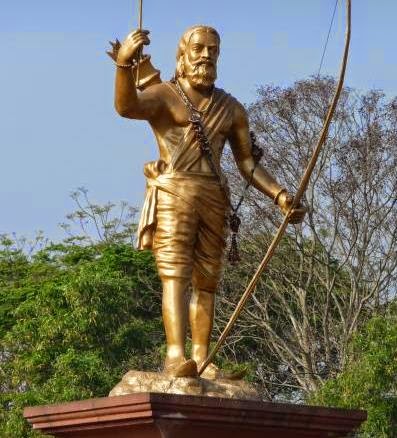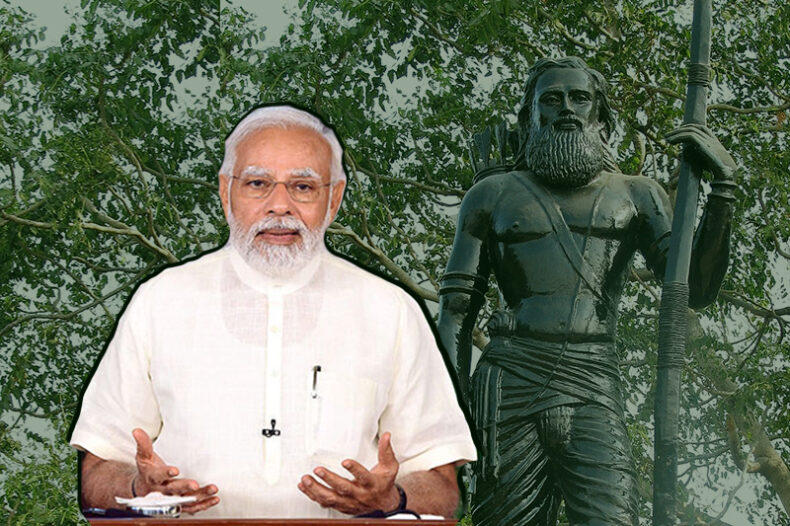Commemorating the 125th birth anniversary of freedom fighter Alluri Sitharam Raju, PM Modi unveiled a bronze statue on the 4th July.

Source: alluri seetharama raju photos – Bing images
Bhimavaram: Prime Minister Narendra Modi unveiled a 30-foot-tall bronze statue of Alluri Sitharam Raju in Bhimavaram, Andhra Pradesh on Monday, July 4.
The bronze statue pays a tribute to the legendary freedom fighter who led the Rampa rebellion against the British.The statue weighed 15-tonnes and has been built at a cost of Rs 3 crore.
The Government of India has begun a campaign as a part of “Azadi Ka Amrit Mahotsav” to celebrate the “Unsung Heroes” of Indian independence struggle.
The government has said it is “committed to giving due recognition to the contribution of freedom fighters and making people across the country aware of them”.
While addressing the nation during the inauguration, PM Modi said that the nation will throughout the year celebrate the 125th birth anniversary of Alluri Sitharam Raju Garu and 100 years of Rampa Kranti.
To quote him, “As the country celebrates the Amrit Mahotsav of 75 years of independence, we alongside celebrate the 125th anniversary of Alluri Sitarama Raju.
At the same time, 100 years of ‘Rampa Kranti’ for the country’s independence are also completed. I bow down my head and give a tribute to him.”
Mr. Modi noted that the Rampa rebellion was “a symbol of the strength of our diversity, culture and of our unity as a nation.” Calling the journey of Sitharam’s life an inspiration to us all, PM Modi recognised his ambitions to secure the rights for the tribal society at the age of 27.
He said, “Alluri Sitarama Raju dedicated his life for the good of others and for bringing Kranti during the freedom struggle.”
Acknowledging the people of Andhra Pradesh and their contributions in the freedom struggle PM Modi said, “Andhra Pradesh is the land of heroes and patriots.
Here there were freedom heroes like Pingali Venkayya, who prepared the flag of the country. This is the land of heroes like Kanneganti Hanumanthu, Kandukuri Veeresalingam Pantulu and Potti Sriramulu.”
Celebrating 75 years of Independence, the Prime Minister stated, “..we need to build an India that symbolizes the vision of our great freedom fighters. A country with equal opportunities, rapid growth and a country where 133 crore citizens come together for the vision of a New India.
Today, for the first time after Independence, to create awareness about Adivasi Gaurav and Viraasat we are building museums to tell the story of the great tribal leaders of India.”
PM Narendra Modi stated that the restoration of Alluri’s birthplace, the renovation of Chintapalli police station and the construction of Alluri temple in Mogallu which symbolises the spirit of Amrit Mohatsav.
Who is Alluri Sitharam Raju?
Alluri Sitharam Raju was an Indian revolutionary, crusader of tribal rights and the unsung hero of India’s struggle to independence.
He was born on July 4th, 1897 in the village of Mogallu of Palakoderu Mandal in West Godavari district of Andhra Pradesh. He led the Rampa rebellion also known as the “Manyam Veerudu” in 1922.
Venkata Rama Raju, his father, was a photographer and his mother, Suryanarayanamma, a home-maker. He completed his schooling at Bhimavaram, Narsapuram and Visakhapatnam.
One of the famous incidents of his life was when Alluri threw the badge with King George’s picture on it, at the age of 13. “To wear them is to flaunt our servitude.
But I pinned it on my shirt near my heart to remind all of you that a foreign ruler is crushing our lives,” said Alluri Sitharama Raju, as he threw all but one of the badges with King George’s picture on it, that his friend gave him.
What was the Rampa Rebellion?
The Madras Forest Act was implemented in 1882 making the life of tribal people miserable by prohibiting Podu cultivation, an age-old-cultivation by the tribal people where they cannot use the cultivation process of the plains.
He led the tribal people against the British oppression taking up the cudgels for tribal rights.
The rebellion thus began in August 1922 and lasted until the capture and killing of Raju in May 1924. Alluri Sitharam Raju became a sanyasi at the age of 18.
He was a man of justice and strong determination, who raised his voice for the rights of the tribals against the strong, oppressionist forces of the British.
Harnessing the dissatisfied tribals, he led an anti-colonialist agitation, whilst also accommodating the grievances of those Muttadars who were sympathetic to his aim.
He resorted to guerrilla warfare to fight against the British. Though not much happened as an aftermath to the rebellion, yet it had a ripple effect in the long run when mass struggle began under the aegis of Gandhi and others.
One must always remember his roots especially when you have a heritage and culture as enriched and gratifying as that of INDIA!












